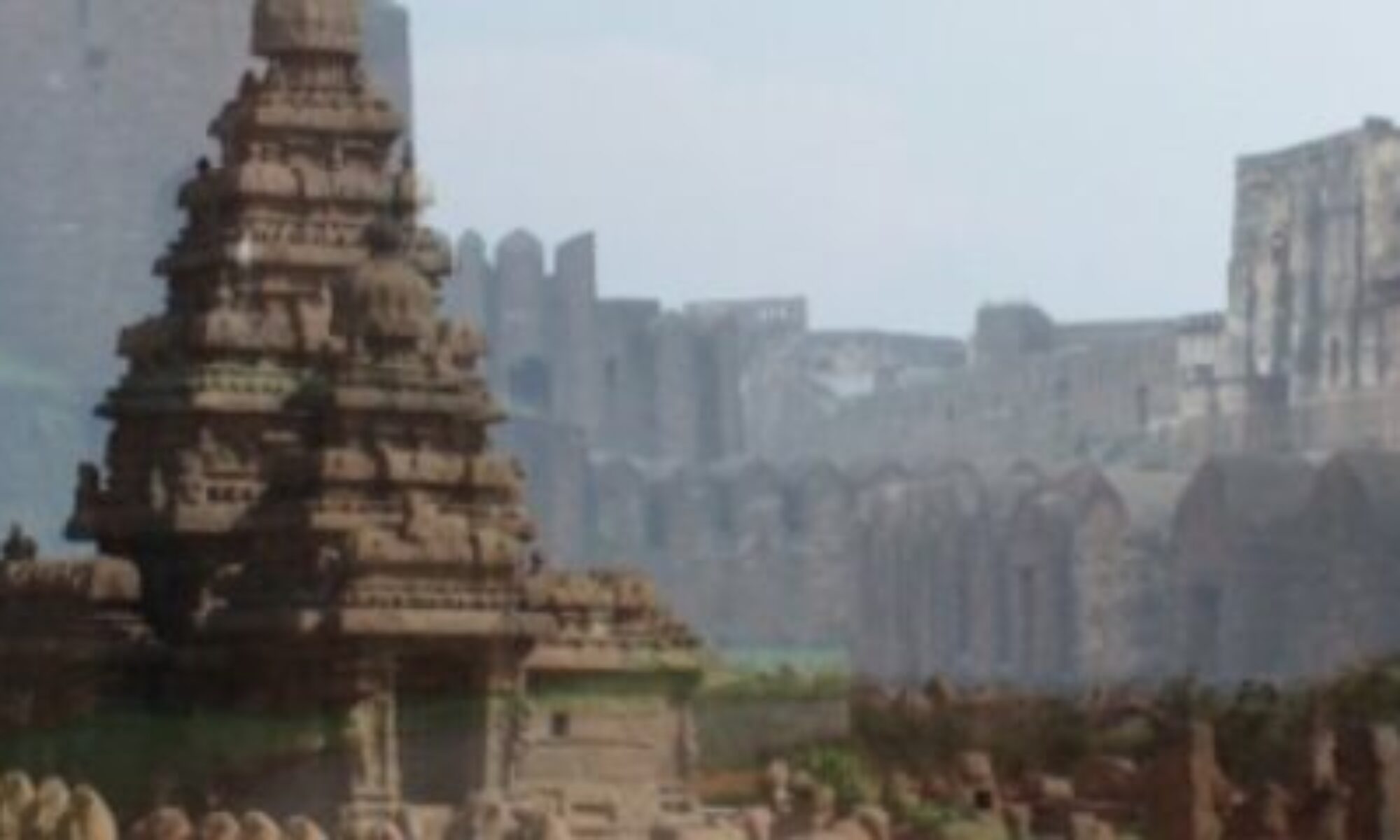Once I reached the hotel in Aurangabad, it was late night. I still could catch some nice sleep and wake up fresh in the morning and raring to start my trip. I hired an auto rickshaw to take to all the relevant places. As always, I had my itinerary and the list of the places. I should thank the driver Sriram, for being patient with me and bear my antics.
This place is one of the most important places in the Deccan, for it was the entrance. The Daulatabad Fort, at a distance of 15 kilometers from here was always under the radar of any conqueror who looks towards South India, ever since the time of Mohammed Bin Tughlak. It was aptly called “Khidki” (window) earlier. The present name had been given by Aurangzeb when he invaded Daulatabad. It was also the capital city in the Deccan during his regime. The city was named Fateh Nagar, after Malik Ambar’s son who was the Prime Minister of Sultana Chand Bibi of Ahmednagar. After the death of Aurangzeb, it came under the control of the Nizam of Hyderabad as his capital city, which was later moved to Hyderabad.
The most interesting aspect of this place is that it has a multi cultural historical importance. It houses one of the oldest Buddhist Cave Temples of India. Let us start with them….
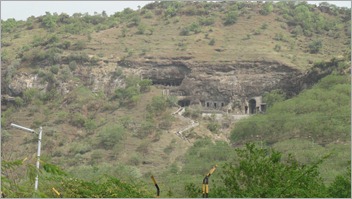 We can have the first view of the caves from almost 2 miles and its amazing. There are 12 in number strewn on one side of a hillock. running roughly east to west. The caves were hewn at a height of 70 feet from the ground level. The rock formation in the hill is not entirely suitable for excavation, hence at many places the rock surfaces have collapsed or developed cracks. This was the reason that many caves were left unfinished. The site was earlier reached after a hard climb, so they were skipped by tourists. However, today there are good approach roads setup by the ASI and it is easy to reach.
We can have the first view of the caves from almost 2 miles and its amazing. There are 12 in number strewn on one side of a hillock. running roughly east to west. The caves were hewn at a height of 70 feet from the ground level. The rock formation in the hill is not entirely suitable for excavation, hence at many places the rock surfaces have collapsed or developed cracks. This was the reason that many caves were left unfinished. The site was earlier reached after a hard climb, so they were skipped by tourists. However, today there are good approach roads setup by the ASI and it is easy to reach.
In all, 12 Buddhist caves are excavated in basalt rock which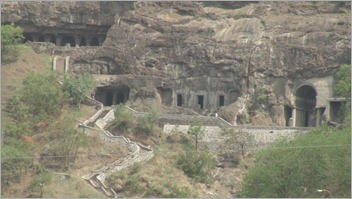 falls into three separate groups. The first group consists of caves 1 to 5; the second from 6 to 9 located to the east of the first group at a distance of nearly 500 m; and third from 10 to 12 which are plain and unfinished cells 1 km further east of the second group. The caves are datable from circa 3rd century AD to 7th century AD and are noted for their architectural and sculptural beauty. The authors and period of the third group is difficult to determine in the absence of any identifiable features. Let us visit each cave and understand their architecture.
falls into three separate groups. The first group consists of caves 1 to 5; the second from 6 to 9 located to the east of the first group at a distance of nearly 500 m; and third from 10 to 12 which are plain and unfinished cells 1 km further east of the second group. The caves are datable from circa 3rd century AD to 7th century AD and are noted for their architectural and sculptural beauty. The authors and period of the third group is difficult to determine in the absence of any identifiable features. Let us visit each cave and understand their architecture.
Cave 1: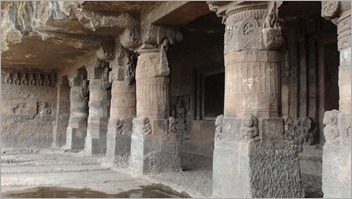 This is a vihara of the 7th century. It has a 75 feet verandah with 8 pillars which have square bases and bracket capitals decorated with females. It will be seen later in this series that this cave has many resemblances with the Cave 1 of Ajanta. On the west is a Buddha on a lotus seat flanked by Nagas with their snake hoods. Nagas, demi-gods who bought rain, were depicted in Buddhism with a crown encircled by snake heads. Outside the verandah, there is a row of eating Buddha at the left end of the wall as you see in the picture to the left. This row of Buddha images are flanked by Padmapani and Vajrapani at each end respectively. Inside are various panels depicting the incidents in Buddha’s life on the walls. There are living quarters on all sides inside the cave. Considering the seated Buddha images outside the verandah, we can infer that this cave belongs to the Mahayana sect. To understand the Buddhist Iconography, please read my previous posts.
This is a vihara of the 7th century. It has a 75 feet verandah with 8 pillars which have square bases and bracket capitals decorated with females. It will be seen later in this series that this cave has many resemblances with the Cave 1 of Ajanta. On the west is a Buddha on a lotus seat flanked by Nagas with their snake hoods. Nagas, demi-gods who bought rain, were depicted in Buddhism with a crown encircled by snake heads. Outside the verandah, there is a row of eating Buddha at the left end of the wall as you see in the picture to the left. This row of Buddha images are flanked by Padmapani and Vajrapani at each end respectively. Inside are various panels depicting the incidents in Buddha’s life on the walls. There are living quarters on all sides inside the cave. Considering the seated Buddha images outside the verandah, we can infer that this cave belongs to the Mahayana sect. To understand the Buddhist Iconography, please read my previous posts.
Cave 2: 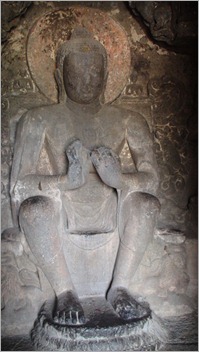 T
T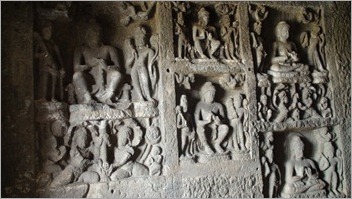 his is a more finished construction. This is a chaitya but its features are completely borrowed from Hindu temples. It does not have the typical stupa, rather it has a sanctum where Buddha sits in a preaching attire with his feet on a lotus. He is accompanied by celestial beings at his side. Inside the cave, is a pradakshinapatha , a circumambulatory around. As I said, on the plan it resembles the structural temples of the period which is
his is a more finished construction. This is a chaitya but its features are completely borrowed from Hindu temples. It does not have the typical stupa, rather it has a sanctum where Buddha sits in a preaching attire with his feet on a lotus. He is accompanied by celestial beings at his side. Inside the cave, is a pradakshinapatha , a circumambulatory around. As I said, on the plan it resembles the structural temples of the period which is 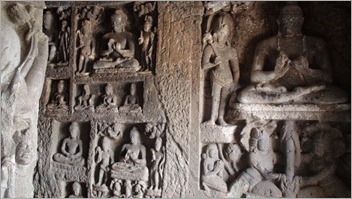 uncommon in rock cut temples. It has a square sanctum, a colonnade and a porch. The entrance of the sanctum is attended by Avalokiteswara, familiarly called Bodhisattva Padmapani. Several figures of Buddha in low relief and and some attended by Vajrapani and Padmapani are seen on the walls all inside the temple. It is very sad that these amazing sculptures are wearing out over time and losing their existence.
uncommon in rock cut temples. It has a square sanctum, a colonnade and a porch. The entrance of the sanctum is attended by Avalokiteswara, familiarly called Bodhisattva Padmapani. Several figures of Buddha in low relief and and some attended by Vajrapani and Padmapani are seen on the walls all inside the temple. It is very sad that these amazing sculptures are wearing out over time and losing their existence.
We will cover the remaining caves in the further posts.
